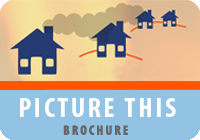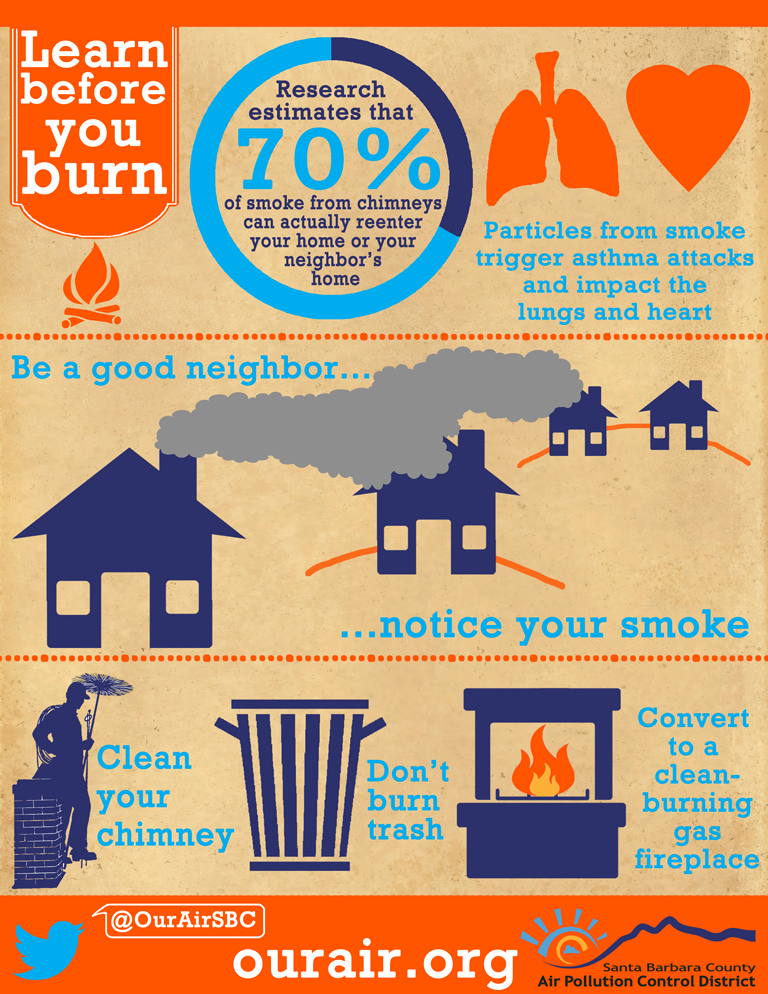During the colder fall and winter months, the District receives complaints from residents concerned about breathing smoke from their neighbors’ fires. Sometimes, the neighbors are not even aware that they have been causing anyone discomfort. The District has found that many people, if they know their smoke is affecting someone, are willing to adopt cleaner fireplace burning methods, or are willing to adjust burn times or notify their neighbors before burning so appropriate precautions can be taken.
If you choose to use your wood burning fireplace or stove, please review the steps below for your health and safety, as well as the health and safety of your neighbors. If you are being affected by a dirty fireplace, please see our complaint process.
Tips for Cleaner Fireplace Burning en español (PDF)
- Burn only dry, well-cured wood. Hard woods are dense, which burn more slowly and evenly. As a result, they produce more heat and less smoke.
- Small hot fires are also better than large smoldering ones. Avoid roaring fires, as they can start chimney fires and can overheat wall and roof materials.
- Don’t burn trash or other fuels. This includes plastics, wrapping paper, magazines, or colored or coated papers (including newspaper inserts and junk mail). Burning trash can cause toxic chemicals to go into the air. Also, never use flammable fuels in or near your fireplace.
- If possible, use your house furnace instead of the fireplace. A fireplace fire is not an efficient way to produce heat. Use your furnace for heat and your fireplace for special occasions.
After you make a fireplace fire, take a walk outside to look and see where your smoke is going. If your smoke is headed towards a neighbor’s house, knock on their door. Ask if your smoke is bothering them and let them know they can call you if it does in the future. Usually, two neighbors can work out a solution that works, but only if they are aware and talk about the issue. Be a good neighbor.
- A dirty chimney is full of flammable creosote. Schedule regular maintenance by a professional chimney sweep.
- A gas fireplace or a fireplace using an EPA-certified insert will create less pollution than a typical wood burning fireplace or stove. See our Wood Smoke Reduction Program for incentive funding for residents to remove or replace their existing wood-burning fireplace or stove.
- Never burn wood in a fireplace that was designed for a gas log. Decorative fireplaces are not built to handle wood fires. Burning wood in one of these fireplaces is asking for trouble and could create a dangerous situation.
- Never leave a fire unattended. Make sure the fire is completely out before going to bed or leaving the house.
- Do not allow small children near the fireplace. Their clothing can easily ignite. Warn the entire family about this hazard.
- Be sure no flammable materials hang down from or decorate your mantel. A spark from your fireplace could ignite these materials and cause a fire. Keep flammable and combustible materials such as carpets, pillows, furniture or papers, logs and kindling at least 3 feet away from the fireplace area. Be sure the Christmas tree is not close enough to be ignited by a spark. Keep the area near the fireplace clear of materials like papers, books, toys, etc.
- Make sure you have basic fire safety equipment. Keep a type ABC extinguisher near the fireplace, install a screen that covers the fireplace opening, equip your house with smoke and carbon monoxide detectors, and use a spark arrester on top of your chimney.
Wood smoke contains the following air pollutants:
- Particulate matter that can be deposited and remain in sensitive areas of our lungs;
- Cancer-causing substances, including benzene, formaldehyde and polycyclic organic matter;
- Carbon monoxide, which reduces the blood’s ability to supply oxygen to tissues;
- Nitrogen oxides (NOx), and hydrocarbons, both involved in the formation of ozone, a principal component of smog.
Breathing wood smoke reduces lung function, aggravates heart and lung diseases, and can trigger asthma. During periods of poor air quality (especially if there is an active wildfire), we recommend you do not use your fireplace at all. Households with sensitive individuals should talk to their doctor before using a wood-burning fireplace or stove.
For more information on the health impacts of smoke, and those most at risk, see Smoke and our Health, the Environmental Protection Agency BurnWise site, and the California Air Resources Board Wood Burning Handbook.
District Role
The District has not adopted any rules or regulations to ban or limit the burning of wood or other solid fuels in a fireplace, wood stove, or other wood-burning device. However, wood-burning appliances and fireplaces in homes and restaurants may cause public complaints and/or a public nuisance. The California Health and Safety Code and District regulations (including Rule 303, Nuisance) prohibit emissions of air contaminants that cause nuisance or annoyance to a considerable number of people, or that present a threat to public health, or damage to property. If complaints are received, District inspectors will investigate to determine compliance with Rule 303. Please see our complaint process for more information.
To avoid the potential for a nuisance situation to occur, we recommend that new construction projects consider limiting wood-burning fireplaces and install natural gas-fueled appliances and fireplaces instead. As for existing fireplaces, our Wood Smoke Reduction Program offers incentive funding for residents to remove or replace their existing wood-burning fireplace or stove.



